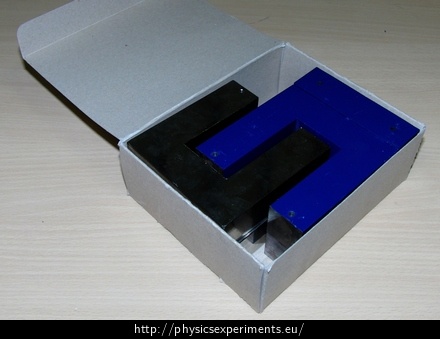Change in Internal Energy by Performing Work: Dragging a Heavy Object
Experiment number : 4342
Goal of experiment
We will illustrate that when dragging a heavy enough object on a mat, it is possible to measure increased temperature of both the mat and the object.
Theory
The First Law of Thermodynamics states:
\[\Delta U\,=\,W\,+\,Q,\]where ΔU is the internal energy change of the system, W is the work done on the system and Q the heat supplied to the system. It means that the change of internal energy of any thermodynamic system (that does not exchange particles with its surroundings) can be done in two ways – heat exchange and doing work. In our case, the work is done by the component of the pulling force acting in the direction of the pulling. The friction between the object and the underlying surface (more accurately: the work done by friction forces) causes the particles of both surfaces to oscillate, thus increasing their temperature.
Equipment
Thermal imaging camera, heavy enough object with a string tied to it.
In this scenario, we used a box filled with transformer cores that can be found in a typical physics classroom. The overall mass is 10.8 kg (Fig. 1).

Procedure
Drag a heavy object on any surface quickly while watching it with a thermal imaging camera.
Sample result
The video below shows a successful execution of the experiment. We can see that the surface of the table is not heated evenly; there are visible heat marks that are created by the friction of the parts of the box that touch the surface of the table the most.
In this video, the FLIR i7 thermal imaging camera was used. The temperature range of the colour scheme was set in the interval of 22 °C and 28 °C, the emissivity was ε = 0.95.
Technical notes
In the sample experiment, the table top was used as the underlying surface; if we are worried about damaging it, linoleum on the floor will serve just as well.
If we perform the experiment on tiles or a carpet, it may be difficult to detect any temperature change (tiles in particular typically have good thermal conductivity and local temperature increases immediately disappear by heat dissipation to the surroundings).
Pedagogical note
The video above only shows the temperature increase of the surface under the object being pulled. Of course, you can also show the temperature increase of the bottom base of the object being pulled, but you need to measure immediately after the movement has stopped, before the temperature differences have time to even out.
Thermal imaging camera basics – link to PDF
In this experiment, a thermographic measurement is used. The theory of thermography and basic recommendation and procedures that can help you obtain more accurate and undistorted results can be found in Experiments with thermal imaging camera (in Czech only).








